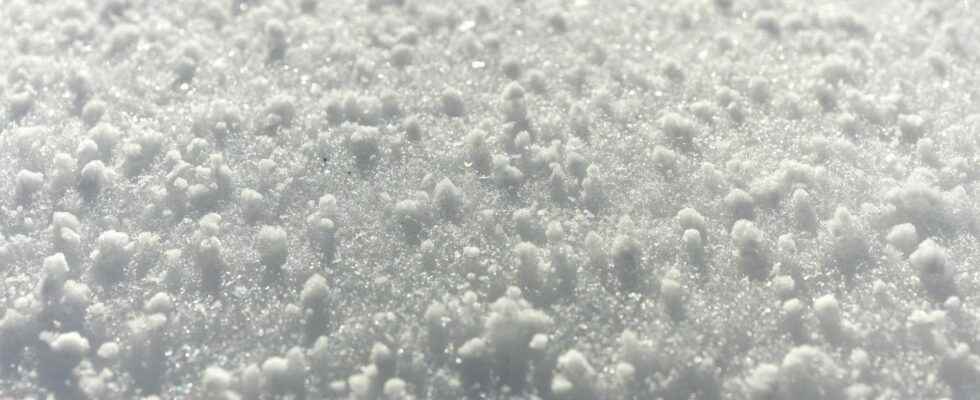You will also be interested
[EN VIDÉO] Kézako: what is matter made of? Why is it solid, liquid or gaseous? The three main states of matter are familiar to us. But if we want to explain why they exist, we have to dive into the heart of matter. So let’s dive into this episode of Kézako, with Unisciel and the University of Lille 1, to discover matter in all its states.
To atmospheric pressureif the temperature drops below 0°C, the water goes from the liquid in the solid state. Or at least, in most cases. Sometimes, if the cooling is done under particularly stable conditions, the water remains liquid, although the temperature is below its crystallization point. This is called the supercooling. This state of matternot only specific to water, is metastable: it can persist as long as no addition ofenergy disturbs the system, and puts it in its most stable state, the solid state.
The experiment can also be done at home: by putting a bottle of water in the freezer, if the latter does not vibrate too much, the water will be supercooled after a few hours. It is then enough to transmit a slight shock to the bottle, and all the water it contains solidifies on sight.eye !
Well known, although still poorly understood, the phenomenon of supercooling is taken into account in various fields, in particular that of aviation. When the temperature is slightly below 0°C, if an aircraft enters a cloud, the latter may contain a few supercooled drops. But as soon as they come into contact with the plane, they solidify and can then cover it with frosted in just a few seconds. Aircraft must therefore have a de-icing system to mitigate this risk. A new study published in Nature Physics focused on the properties thermodynamics of supercooled water, and in particular on its molecular structure.
This water turning to ice as soon as it’s poured
This is supercooled water, water that remains a liquid below its freezing point
Normally, imperfections in water such as dust particles, act as nuclei for crystal structures to grow around 1/????pic.twitter.com/OgK3Oz50ju
— Science girl (@gunsnrosesgirl3) April 30, 2022
Two different liquid phases
For this, the researchers reused a theory established in 1992, which assumes the coexistence of two different liquid phases in supercooled water. Several studies in this direction have shown that, theoretically, a liquid-liquid critical point is possible below zero degrees. But this time, the team used simulations to model the two phases at the microscopic scale, in order to study the characteristics, both of each, but also of the mixture.
They distinguish a phase water called “high density”, and another “low density”. Each has an initial tetrahedral network, but a different arrangement of these tetrahedra: the first is composed of at least two interlocking tetrahedra, while the first consists of a single tetrahedron.
Everything can be modeled as “colloidal” water, that is to say water containing colloidssubstances (here, high-density water) suspended in water large enough to modify the liquid on a large scale, but sufficiently well distributed so that everything is homogeneous. “This colloidal model of water provides a magnifying glass into molecular water and allows us to unlock the secrets of water regarding the history of two liquids”said Dwaipayan Chakrabarti co-author of the study and researcher at the University of Birmingham.
The thermodynamic properties of supercooled water have been well reproduced by the model
Thanks to the simulations, the researchers succeeded in reproducing the macroscopic properties of supercooled wateras they explain in their study: VS“The colloidal water model captures the anomalous thermodynamic behavior of supercooled water, including the well-known density maximum, and displays two structurally different lattice liquid phases.”
Indeed, the liquid transition-liquid established by the researchers occurs only for a sufficiently high pressure, as explained in the study. ” The transition occurs at low temperatures at which the system tends to form a liquid network with the maximum number of bonds possible. At low pressures it is well established that this is achieved by forming an open random tetrahedral network. »
They also showed that these two phases were unstable: the bonds break and reproduce constantly. ” VScontrary to knots and to bonds formed by covalently bonded chains or networks, low-density and high-density liquid phases are transient networks (i.e., bonds are constantly breaking and forming) and their state topological is therefore not constant. Despite this evolution, the topological signatures of each phase are well defined. »
As this coexistence of phases is very hard to study experimentally due to the metastable character of supercooled water (immersing a measuring device in it would be tantamount to changing water into ice, for example), the researchers are delighted with the capacity of the simulations. “In this work, we propose, for the first time, a vision of the phase transition liquid-liquid based on ideas ofentanglement network. I am sure this work will inspire new modelization theory based on topological concepts”, enthused Francesco Sciortino, co-author of the study, who participated in the development of the theory of two liquid phases in 1992.
—
SPECIAL OFFER: subscribe to our media for 3 months and receive the Mag Futura as a gift!*
*Offer valid for any new 3-month subscription to the “I participate in the life of Futura” offer on Patreon.
—
Interested in what you just read?
